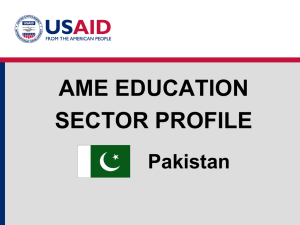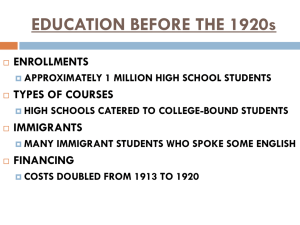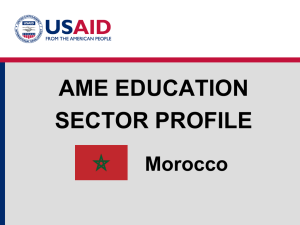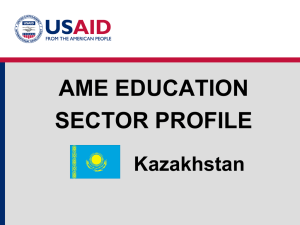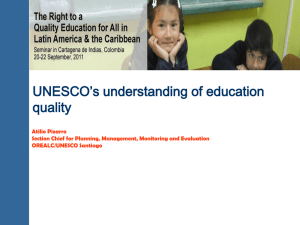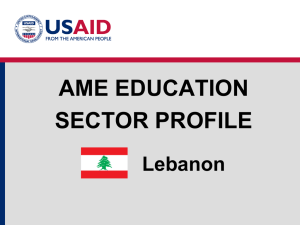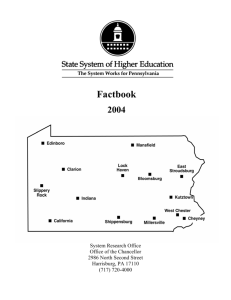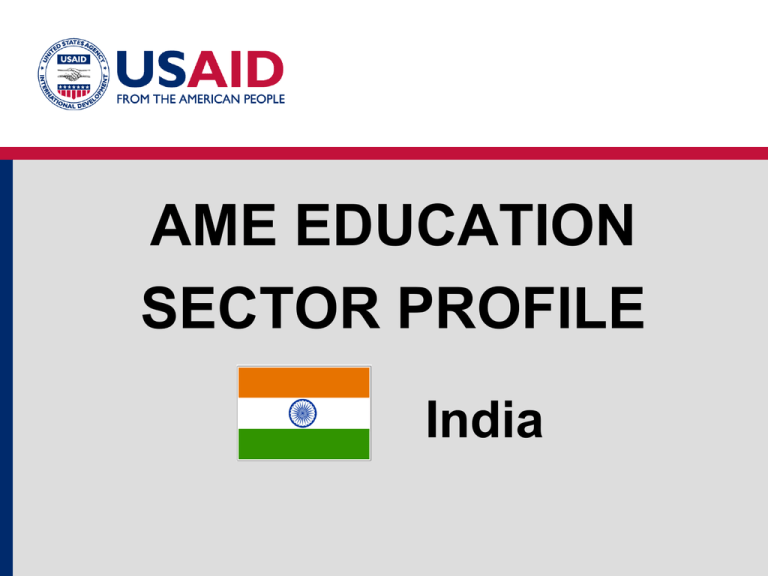
AME EDUCATION
SECTOR PROFILE
India
India
Education Structure
Education System Structure
and Enrollments 2006
Source: India Ministry of Higher Education, UNESCO Institute for Statistics
India
Education Structure
• Education is free and compulsory for all children up to the age of 14.
Education Configuration and Enrollment Percentages
Classification
Pre-primary
Elementary
Secondary
Tertiary
Level/Grade
% Net
% Gross
Enrollments Enrollments
Ages
2006
2006
Pre-school
4-5
N/A
40%
Primary, grades 1-5
6-11
89%
112%
Upper Primary, grades 6-8
11-14
N/A
71%
Secondary, grades 9-10
Senior Secondary, grades
11-12
TVET Secondary
Non-professional
undergrad
15-16
N/A
54%
17-18
17-18
N/A
N/A
28%
3%
Non-professional grad
Professional degree
19-22
19-24
19-21
N/A
12%*
* Includes all categories of post-secondary.
Source: India Ministry of Higher Education, UNESCO Institute for Statistics ,
India
Population Structure
• India has a relatively young population with 60% below the age of
30.
• The government will need to focus on providing good education
opportunities for youth in order to support country economic growth.
Population Structure: India 2008 (est.)
15-29 years
28%
0-14 years
32%
65+
5%
Source: International Labor Organization
30-65 years
35%
India
Education Policy
Relevant Policies:
• Eleventh Five Year Plan 2007-2012
• Education for All: National Plan of Action for India
2003-2015
• Scheme for Universalization of Secondary and
Higher Secondary Education 2009
All policies available at:
http://planipolis.iiep.unesco.org/format_liste1_en.php?Chp2=India
India
Education Access: Pre-university
• Primary levels have grown an average of 11% since 1990.
• Secondary levels have grown an average of 20% since 2001.
Pre-university Gross Enrollments
120
1990
Percentage Enrollment
100
2006
80
60
40
* All
secondary
data from
2001
20
0
Pre-primary
Primary
Upper Primary
Secondary
Senior
Secondary
Source: India Department of Higher Education 2006, UNESCO Institute for Statistics
India
Education Access: Tertiary
• Higher education enrollments at 12% are considerably below the
ASEAN regional average of 23%.
•Enrollments in all categories have more than doubled since 1990.
Post-secondary Enrollments
Numbers of Students
25,000
20,000
1990
15,000
2005
10,000
5,000
0
Post Grad
Source: World Bank 2005
Bachelor
2-3 year
Total
India
Education Access: Gender
• Primary/upper primary girls enrollment rates have increased 21%
since 1990 while boys have decreased 2.1%.
• Increases at the secondary levels since 2000 have not been so
dramatic: girls 8.1% and boys 6.4%.
Pre-university Enrollments by Gender
110.0
Enrollments (%)
100.0
90.0
80.0
Prim/Upper
prim Boys
70.0
Prim/Upper
prim Girls
60.0
50.0
Sec/ Senior
Sec Boys
40.0
Sec/ Senior
Sec Girls
30.0
20.0
1990
2000
2004
2006
Source: India Department of Higher Education, Department of School Education and Literacy
India
Education Quality: Teachers
• India has approximately 6 million teachers at all levels.
•The proportion of primary teachers with pre-service education
qualifications increased from 66% in 2003-04 to 73% in 2005-06.
• At the upper secondary level (grades 6-8), the proportion of teachers
with pre-service education qualifications increased from 69% to 79%
in the same period.
• Pre-service professional development is offered at public and
increasingly, at private colleges but is reportedly of poor quality, the
result of an inadequate monitoring and accreditation system..
•Little information is available on the content and effectiveness of inservice teacher training.
Source: India Ministry of Human Resources, World Bank 2009
India
Education Quality: Completion
• Completion rates are improving slowly, approximately 2.2% a year
since 2000.
• Girls’ completion rates have increased17% since 2000.
Primary (Grades 1-5) Completion Rates
Completions (%)
100
90
80
70
60
50
1990
2000
Boys
Source: World Bank EdStats
2003
Girls
Total
2006
India
Education Quality: Testing
• India does not participate in international achievement
examinations such as TIMSS.
• A learning achievement survey conducted by the Indian
National Council for Education Research and Training
in 2003 and 2007 highlighted the poor learning
achievement and small gains made at grade 5.
Learning Achievements Grade 5 Years 2003 and 2006
Math
Language
Science
2003
46.5%
58.6%
50.3%
2007
48.6%
60.3%
52.2%
Source: India Ministry of human Resource Development
India
Education Equity: Gender/ Geographic Disparities
• Many students have difficulty accessing secondary education, rural
females the most so.
• 85% of all students are able to access primary education.
School Attendance by Age, Sex and Location
0
AGE 6-10 URBAN Male
Female
AGE 6-10 RURAL Male
Female
AGE 11-14 URBAN Male
Female
AGE 11-14 RURAL Male
Female
AGE 15-17 URBAN Male
Female
AGE 15-17 RURAL Male
Female
10
20
30
40
Attendance (%)
50
60
70
80
90
88
88
84
79
83
81
79
66
52
51
47
28
Source: India Demographic and Health Survey 2005-06
100
India
Education Equity: Income Disparities
• 74% of out-of-school primary children come from the two poorest
wealth quintiles.
Out-of-school Primary Children by Wealth Quintile
Poorest Q
47%
2nd Q
26%
Richest
4%
4th Q
8%
Source: India Demographic and Health Survey 2005-06
3rd Q
15%
India
Education Equity: Income Disparities
• All children seemingly have difficulty attending secondary
education, the children from poorer wealth groups more so than
richer students.
Elementary Education Completion/Secondary Education
Attendance by Wealth Quintile 2004-05 (%)
80
76
Rates (%)
70
63
60
Attendance
of Secondary
Education
47
50
40
68
55
53
38
42
35
30
29
20
Poorest Q
Source: World Bank 2009
Q2
Q3
Q4
Completion
of
Elementary
Education
Richest Q
India
Education Equity: Academic Disparities
• Lower social castes’ ability to attend school and achieve literacy is
from 10-20% lower than the rest of the student population.
Primary Student Characteristics by Caste/Tribe
90
Population (%)
80
70
60
50
Attend school
40
Read and Write
30
S Tribe
Source: UNICEF 2006
S Caste
OBC
Others
India
Education Equity: Academic Disparities
• Nearly 60% of the share of secondary enrollments is privately offered
and the number of schools has doubled (to 30%) from 1993 to 2004.
•There is no evidence to show however, that private institutions offer an
education of better quality than public schools do.
Private Share of Education 2000 (%)
Secondary
Gen, 55.2
Low
Secondary ,
34.1
TVET
Secondary,
12.2
Primary, 16.5
Pre-primary, 3
Source: UNESCO Institute for Statistics, India Ministry of Human Development (2008)
India
Education Efficiency: Expenditure
• India spends 50% of its education budget on compulsory education,
grades 1-9 (primary and upper primary levels).
Spending Pattern 2004
Upper
Primary
13%
Secondary
29%
Tertiary
20%
Primary
37%
Source: UNESCO Institute for Statistics
Pre-primary
1%
India
Education Efficiency: Expenditure
• Relative to other lower- to lower-middle income countries in the
region, India spends less money on education as a percent of all
public spending.
Public Spending on Education in ASEAN as Percentage
(Most recent data 200-2006)
OECD
ASEAN
% Public
Spending
Bangladesh
% GDP
Laos
Indonesia
India
Cambodia
Timor-Leste
Philippines
0.0%
5.0%
10.0%
15.0%
20.0%
Source: World Bank Education at a Glance, Global Monitoring Report 2008
25.0%
30.0%
India
Education Efficiency: Repetition
• Repetition appears to be a small issue, averaging 3.6% at
primary and 4.5% at secondary levels. School drop-out rates are
the more significant problem to the Indian government.
Source: UNESCO Institute for Statistics
India
Education Efficiency: Repetition
•India appears to be as efficient at controlling repetition rates as other
regional countries with similar education budgets, despite having
such a large school population.
14
12
%GDP
Percentages
10
8
6
4
2
0
Source: World Bank EdStats, UNESCAP
Repetition
India
Education: Conclusion
Successes:
• Access: Growing enrollments all levels. High elementary levels.
• Quality: Steady improvement in completion rates at primary level.
• Equity: Strong female enrollment and completion rates at primary levels.
• Efficiency: Increasing public education expenditures. Low/stabilized
repetition rates.
Challenges:
• Access: Low secondary enrollments especially for females.
• Quality: Poor student academic achievement at primary levels. No
systematic measurement of student academic achievement. Poor
professional teacher preparation.
• Equity: Geographic, social, and wealth disparities in school enrollments
especially at upper education levels.
• Efficiency: Much smaller amount of funding allocated to secondary
education. High rate of private provision of education at secondary level but
of questionable quality.

